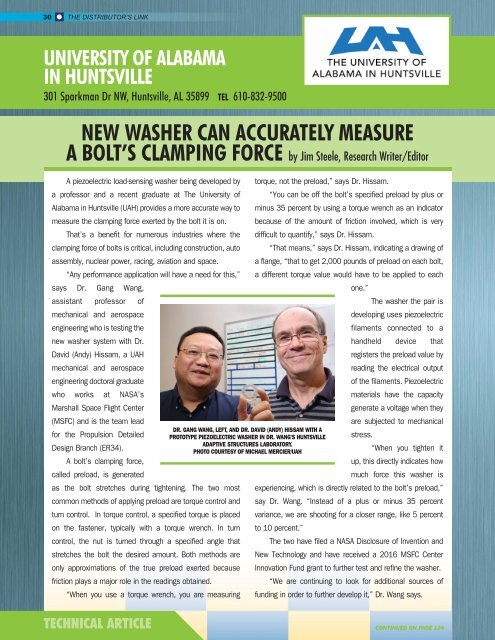WINTER 2016
Distributor's Link Magazine Winter Issue 2016 / Vol 39 No1
Distributor's Link Magazine Winter Issue 2016 / Vol 39 No1
You also want an ePaper? Increase the reach of your titles
YUMPU automatically turns print PDFs into web optimized ePapers that Google loves.
30 THE DISTRIBUTOR’S LINK<br />
UNIVERSITY OF ALABAMA<br />
IN HUNTSVILLE<br />
301 Sparkman Dr NW, Huntsville, AL 35899 TEL 610-832-9500<br />
NEW WASHER CAN ACCURATELY MEASURE<br />
A BOLT’S CLAMPING FORCE by Jim Steele, Research Writer/Editor<br />
A piezoelectric load-sensing washer being developed by<br />
a professor and a recent graduate at The University of<br />
Alabama in Huntsville (UAH) provides a more accurate way to<br />
measure the clamping force exerted by the bolt it is on.<br />
That’s a benefit for numerous industries where the<br />
clamping force of bolts is critical, including construction, auto<br />
assembly, nuclear power, racing, aviation and space.<br />
“Any performance application will have a need for this,”<br />
says Dr. Gang Wang,<br />
assistant professor of<br />
mechanical and aerospace<br />
engineering who is testing the<br />
new washer system with Dr.<br />
David (Andy) Hissam, a UAH<br />
mechanical and aerospace<br />
engineering doctoral graduate<br />
who works at NASA’s<br />
Marshall Space Flight Center<br />
(MSFC) and is the team lead<br />
for the Propulsion Detailed<br />
Design Branch (ER34).<br />
A bolt’s clamping force,<br />
called preload, is generated<br />
as the bolt stretches during tightening. The two most<br />
common methods of applying preload are torque control and<br />
turn control. In torque control, a specified torque is placed<br />
on the fastener, typically with a torque wrench. In turn<br />
control, the nut is turned through a specified angle that<br />
stretches the bolt the desired amount. Both methods are<br />
only approximations of the true preload exerted because<br />
friction plays a major role in the readings obtained.<br />
“When you use a torque wrench, you are measuring<br />
torque, not the preload,” says Dr. Hissam.<br />
“You can be off the bolt’s specified preload by plus or<br />
minus 35 percent by using a torque wrench as an indicator<br />
because of the amount of friction involved, which is very<br />
difficult to quantify,” says Dr. Hissam.<br />
DR. GANG WANG, LEFT, AND DR. DAVID (ANDY) HISSAM WITH A<br />
PROTOTYPE PIEZOELECTRIC WASHER IN DR. WANG’S HUNTSVILLE<br />
ADAPTIVE STRUCTURES LABORATORY.<br />
PHOTO COURTESY OF MICHAEL MERCIER/UAH<br />
“That means,” says Dr. Hissam, indicating a drawing of<br />
a flange, “that to get 2,000 pounds of preload on each bolt,<br />
a different torque value would have to be applied to each<br />
one.”<br />
The washer the pair is<br />
developing uses piezoelectric<br />
filaments connected to a<br />
handheld device that<br />
registers the preload value by<br />
reading the electrical output<br />
of the filaments. Piezoelectric<br />
materials have the capacity<br />
generate a voltage when they<br />
are subjected to mechanical<br />
stress.<br />
“When you tighten it<br />
up, this directly indicates how<br />
much force this washer is<br />
experiencing, which is directly related to the bolt’s preload,”<br />
say Dr. Wang. “Instead of a plus or minus 35 percent<br />
variance, we are shooting for a closer range, like 5 percent<br />
to 10 percent.”<br />
The two have filed a NASA Disclosure of Invention and<br />
New Technology and have received a <strong>2016</strong> MSFC Center<br />
Innovation Fund grant to further test and refine the washer.<br />
“We are continuing to look for additional sources of<br />
funding in order to further develop it,” Dr. Wang says.<br />
TECHNICAL ARTICLE CONTINUED ON PAGE 124

















